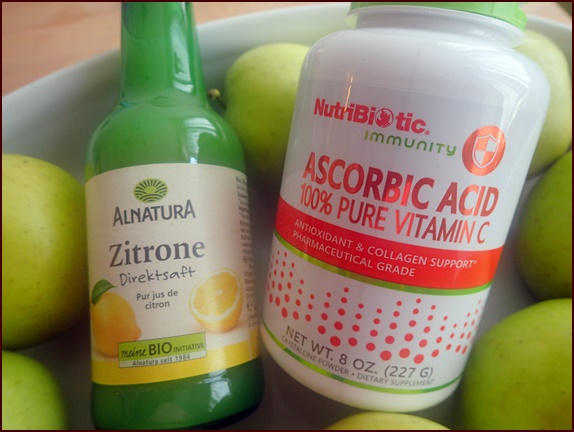How to Pretreat Apples for Dehydrating
Pretreating apples before dehydrating reduces the browning that may occur when apples are cut open and exposed to air. While apples that turn light-brown during dehydration still taste good, a short pretreatment helps them retain their fresh color.
Photo: Lemon juice and ascorbic acid for pretreating apples before dehydrating.
For this article, I conducted experiments to show how to
pretreat apples for dehydrating using methods recommended by several university
agricultural extension services, including Purdue University Extension.
I assessed the color retention and taste of the dried apples, and compared the pretreated apples with apples that were dehydrated without a pretreatment.
Pretreatments Tested for Dehydrating Apples:
- Ascorbic Acid & Water
- Lemon Juice & Water
- Blanching
- Plain Water
Table of Contents
Do you need to pretreat apples before dehydrating?
Pretreating Apples for Dehydration
Why do cut apples turn brown?
Apples contain phenolic compounds and the enzyme, polyphenol oxidase. These elements reside in different parts of the apple’s cells. When an apple is cut open, the phenols in the damaged cells come in contact with oxygen, and the polyphenol oxidase enzyme acts as a catalyst causing a chemical reaction called enzymatic browning, a type of oxidation. The browning effect also occurs in pears, peaches, and apricots.
Source: Professor Christopher Watkins, Cornell School of Integrative Plant Science, quoted in this article by Zoe Denenberg at Epicurious.com. Ways to Keep Apples from Turning Brown.
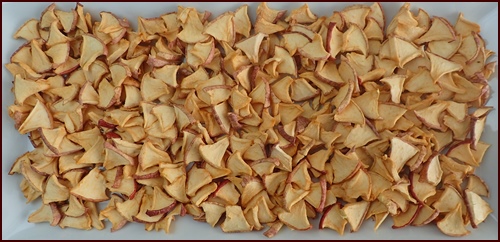
Photo: Slightly browned apple slices dried without pretreatment, after storage in an airtight jar for six months. The flavor was still good.
Do you need to pretreat apples before dehydrating?
I have been dehydrating apples for many years without pretreating them. I ate them all—even the ones that got a little darker, and I enjoyed them very much.
From the perspective of my taste buds, pretreating apples before dehydrating is optional, but pretreating offers the benefit of reducing oxidative browning. Additionally, Purdue University Extension states that “studies have shown that pretreating with an acidic solution enhances the destruction of potentially harmful bacteria during drying.”
To retain the fresh-cut color of apples, a short soak using one of the methods in this article will do the trick. Ascorbic acid or lemon juice pretreatments also add vitamin C to the apples, which declines in fruits during dehydration. These citrusy pretreatments make dried apples more tart, which you may or may not like.
Ascorbic acid and lemon juice are antioxidants, which prevent oxidative browning while apples dry and during storage. However, the most effective way to prevent further darkening of dried apples in storage is to store them in an airtight container with an oxygen absorber, away from heat and light.
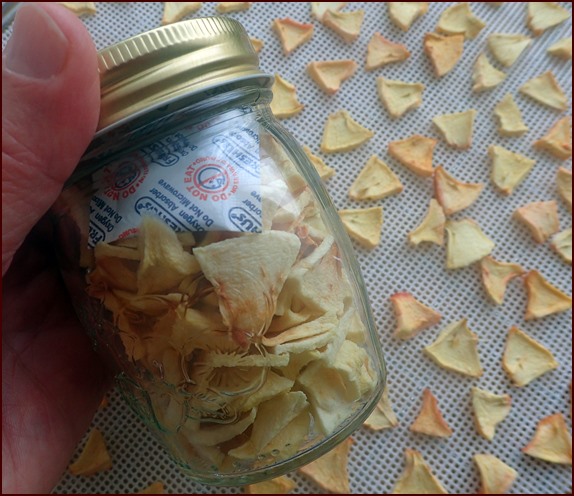
Photo: Storing dried apples in an airtight container with an oxygen absorber will prevent further oxidative browning. Apples in photo were dried without pretreatment, so there was some darkening during dehydration.
During prepping and dehydration, apple slices won’t turn fully brown, as the term, oxidative browning, implies. The color change may be minimal, like golden-beige. The cellular chemistry of apples varies by type; some will turn darker than others when exposed to oxygen. The age of the apples is also a factor.
With over 30 varieties of apples grown commercially, I encourage you to run this experiment with your favorite apple variety.
Now on to the experiment!
For my pretreatment demonstration, I used Golden Delicious apples, which are mildly sweet.
Pretreating Apples for Dehydration
Equipment & Supplies:
- Cosori stainless-steel dehydrator with silicone mesh sheets.
- Sauce pan.
- Large bowl.
- Ascorbic acid powder, 3.75 teaspoons (18 g).
- Lemon juice: 200 ml bottled (6.7 oz.), or 6 fresh lemons.
Preparing Apples for Dehydration:
For the experiment, I pretreated two apples with each method, because two apples will fit on one Cosori dehydrator tray, allowing for space between the slices for better air circulation.
- Prepare the soaking solution in a bowl that will accommodate two apples and half-a-liter of liquid.
- Peel one apple at a time, then cut it into quarters from the stem down. Cut out the stem and core area in the center of each quarter, and place the apple quarters in the soaking solution.
- Repeat for the second apple. Peels may be left on if you prefer, but be sure to wash the apples first.
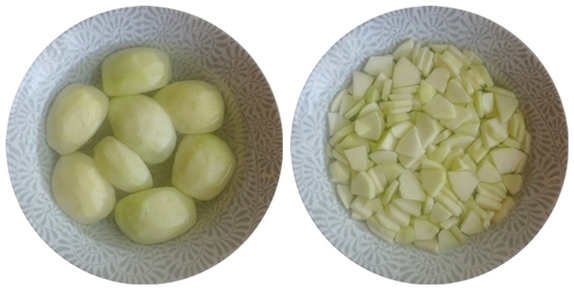
Photo: Two peeled and quartered apples in soaking solution on left, cut into slices on right. Total soaking time: 10 minutes.
- Take out one apple quarter at a time and cut it one more time lengthwise, then cut those pieces together crosswise into ⅛-inch to ¼-inch thick slices. If larger pieces are preferred, skip the first lengthwise cut.
- As you slice each apple quarter, place the slices back in the soaking bowl before slicing the next one. Since apples float, stir the apples a few times while processing to ensure good coverage.
- It takes about 10 minutes to cut two apples, which is the amount of pretreatment time recommended.
Dehydrating Pretreated Apples
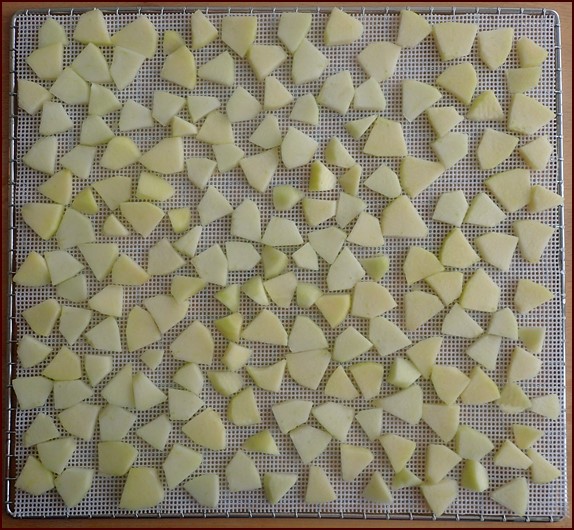
Photo: Sliced apples pretreated with a lemon juice and water solution on a Cosori dehydrator tray using a silicone mesh sheet.
Place apple slices on dehydrator tray directly from soaking solution. A slotted spoon works well. Arrange slices in a single layer with a little space between the slices. There is no need to pat dry. Surface liquid evaporates quickly.
Dehydrate apples at 135°F (57°C) for approximately eight hours.
Ascorbic
Acid & Water Pretreatment
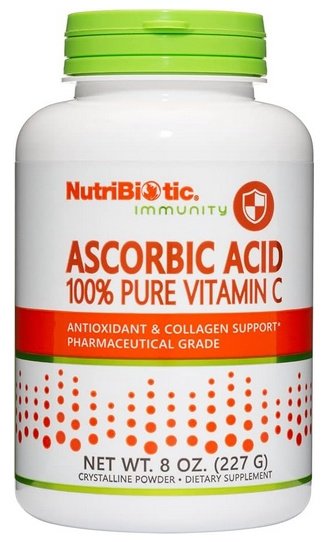
Photo: NutriBiotic Ascorbic Acid Vitamin C Powder, 8 oz.
Ascorbic acid powder can be found in pharmacies, or you can order it through Amazon.
It is inexpensive—an 18 gram portion used to treat half-a-liter of water costs about one dollar. It dissolves instantly in cool water.
Steps:
- Dissolve 3.75 teaspoons (18 g) of pure ascorbic acid powder in half-a-liter of cool water.
- Place apple pieces into the ascorbic acid-water solution as you cut them; 10 minutes per two apples. Pretreatment solution can be used again for more apples if you want to continue with this method.
- Place pretreated apple slices on dehydrator tray directly from ascorbic acid soaking solution. A slotted spoon works well. Arrange slices in a single layer with a little space between the slices.
- Dehydrate apples at 135°F (57°C) for approximately eight hours.
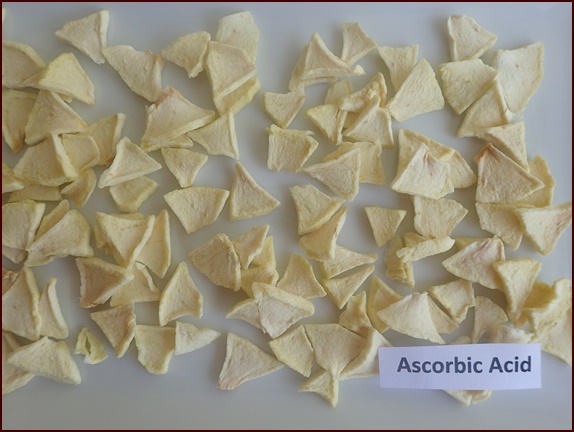
Photo: Dehydrated apples pretreated with ascorbic acid solution.
Results:
Color: No browning, almost lighter than before.
Taste: Tartness very noticeable, overpowers the natural sweetness of the apples.
Lemon Juice & Water Pretreatment
For the lemon juice apple pretreatment, I ran two experiments; one with bottled lemon juice, and one with fresh-squeezed lemon juice.
For the first experiment, I used a 200 ml (6.7 oz.) bottle of pure lemon juice, not from concentrate. The lemon juice was pasteurized, and contained no preservatives. I found it at a local grocery store in Switzerland. The cost for one 200 ml bottle was about two dollars.

Looking for a similar product in the USA, I discovered that bottled lemon juice is usually made from water and lemon concentrate, with added preservatives like sodium benzoate and sodium metabisulfite. While these preservatives could help prevent browning in the apples, many people avoid sulfites due to sensitivities.
Steps:
- Bottled Lemon Juice: Combine 200 ml–236 ml lemon juice (6.7 oz.–8 oz.) with an equal quantity of cool water.
- Fresh-Squeezed Lemon Juice: Juice approximately six lemons until you have one cup of lemon juice (8 oz. or 236 ml). Combine with one cup of cool water.
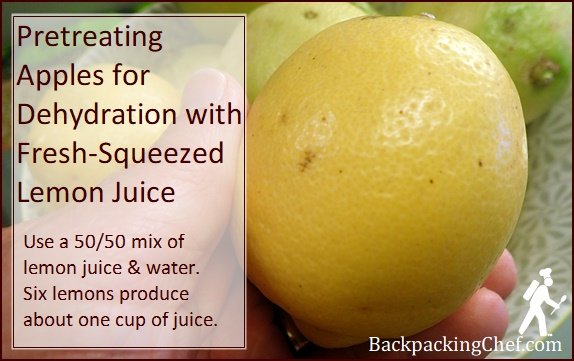
- Place apple pieces into the lemon juice-water solution as you cut them; 10 minutes per two apples. Pretreatment solution can be used again for more apples if you want to continue with this method.
- Place pretreated apple slices on dehydrator tray directly from lemon-water soaking solution. A slotted spoon works well. Arrange slices in a single layer with a little space between the slices.
- Dehydrate apples at 135°F (57°C) for approximately eight hours.
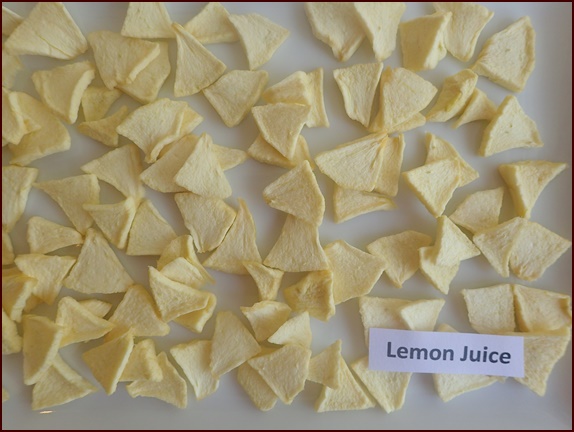
Photo: Dehydrated apples pretreated with lemon juice. The appearance was the same for both fresh and bottled lemon juice.
Bottled Lemon Juice Results:
Color: No browning, a slight yellow tint compared to ascorbic acid soak.
Taste: Lemon (sour) taste was more noticeable than the apple taste, but less tart than the ascorbic acid method.
Fresh-Squeezed Lemon Juice Results:
Color: No browning, light, natural color.
Taste: Lemon taste was noticeable, but tasted more natural than the bottled lemon juice. Still cancels out most of the sweetness in the apples. Pretty good combination if you like tart apples. I found the taste pleasant.
Note: Since I liked the natural taste from the fresh-squeezed lemon treatment, I repeated the experiment using Gala apples. See: Gala Apple-Lemon Juice Treatment Results.
Blanching
Pretreatment
Dipping apples briefly in boiled water for two minutes stops all enzymatic activity.
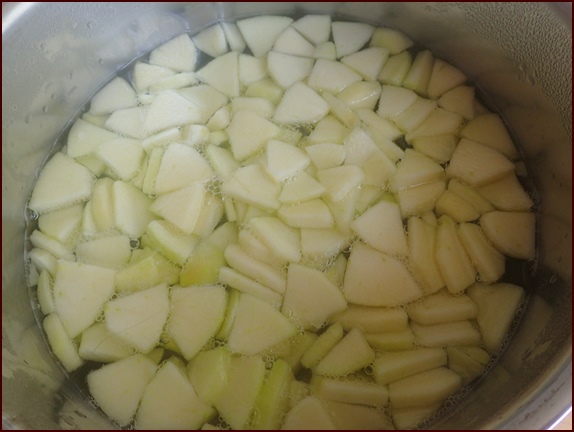
Photo: Apple slices dropped into boiled water.
Steps:
- Bring half-a-liter of water to a near boil, so it’s close to ready when you finish cutting two apples.
- Cut apples into slices.
- Bring water to full boil, then remove pot from stove.
- Drop apple slices into boiled water and let them soak for two minutes.
- Drain though a colander and briefly dip the apples in cold water to cool them off, and to stop them from cooking.
- Arrange blanched apple slices on dehydrator tray in a single layer with a little space between the slices.
- Dehydrate blanched apples at 135°F (57°C) for approximately eight hours.
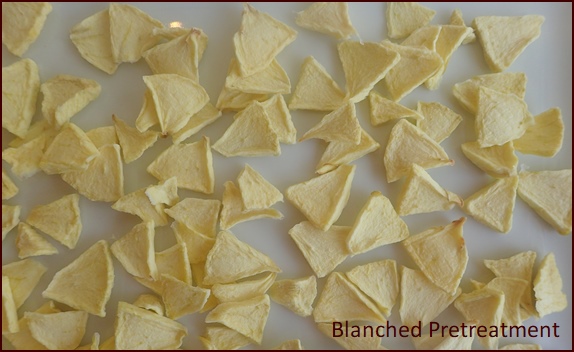
Photo: Dried apple slices after blanching pretreatment.
Results:
Color: No browning.
Taste: Not much flavor.
Texture: Compared to the other pretreatments, the dried blanched apples were a little rubbery.
Vitamin Loss: Water-soluble vitamins like C and the B vitamins, were probably lost due to exposure to hot water.
Plain Water Pretreatment
The theory behind running the experiment using plain water was that less oxygen would be available in the water to participate in the enzymatic browning reaction, compared to air.
Steps:
- Place apples in bowl of cool water as you cut them; 10 minutes per two apples.
- Arrange apple slices on dehydrator tray in a single layer with a little space between the slices.
- Dehydrate apples at 135°F (57°C) for approximately eight hours.
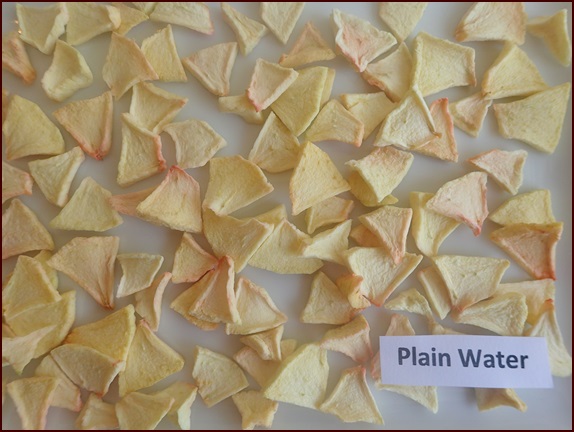
Photo: Apples soaked in plain water for 10 minutes before drying. This treatment did not prevent oxidative browning.
Results:
Color: Slight browning, comparable to apples dried with no pretreatment.
Taste: Natural sweetness of the apples present, but some flavor probably lost in the water soak.
No
Pretreatment
Steps:
- Peel and cut apples into slices.
- Two medium-sized apples cut into slices will fit on one Cosori dehydrator tray. Arrange in a single layer with a little space between the slices.
- Dehydrate apple slices at 135°F (57°C) for approximately eight hours.
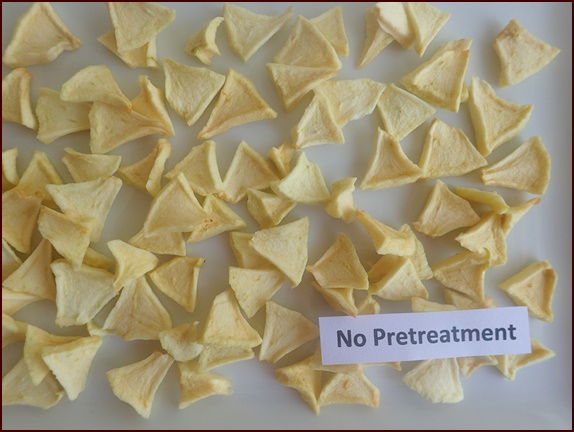
Results:
Color: Slight yellowing, some browning.
Taste: Natural sweet taste of the apples was better than any pretreatment method.
Gala Apples:
Fresh Lemon Juice Treatment vs No Treatment
Of all the treatments tested, I liked the combination of fresh-squeezed lemon juice and water. The lemon juice solution was effective at preventing enzymatic browning, and the lemony flavor of the dried apples was refreshing, but not overpoweringly tart.
Gala apples are sweeter than Golden Delicious apples. The final experiment tested how the fresh-squeezed lemon juice treatment would affect the color and taste of dried Gala apples, compared to no pretreatment.
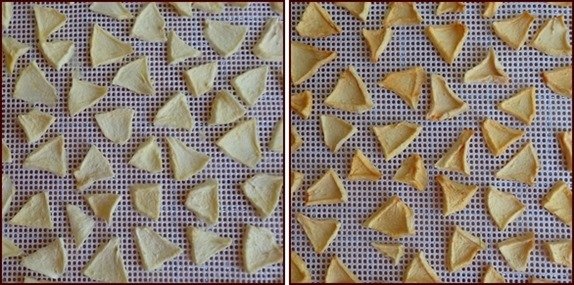
Photo: Gala apple slices treated with fresh lemon juice and water (left), no pretreatment (right).
Results:
Color: Very little color change in apples treated with lemon juice & water. More browning with untreated Gala apples compared to Golden Delicious apples.
Taste: Natural sweet taste of the Gala apples balanced well with the lemon flavor from the treatment. Overall apple flavor was best with no pretreatment.
Conclusion
Pretreating apples for dehydration with ascorbic acid, lemon juice, or blanching, effectively prevents or substantially reduces oxidative browning. Results vary with type of apple.
Ascorbic acid and lemon juice impart a tart flavor to apples. The most pleasant effect was with fresh-squeezed lemon juice.
Soaking apples in plain water is not effective to prevent browning.
Blanching apples before dehydration reduces the flavor, and likely the vitamin content.
The best flavor was retained in apples dried without pretreatment, although untreated apples darkened during processing and drying.
Storing dried apples in an airtight container with an oxygen absorber, or vacuum sealing, keeps oxidative browning from advancing beyond the condition of the apples after they were dried.
Chef Glenn’s Picks: Best way to pretreat apples for dehydrating is with a 50/50 mix of fresh-squeezed lemon juice and water, or no pretreatment at all.
Explore More…
Dehydrating Apples: Five Fun Projects
Shop Amazon
Useful tools for pretreating and dehydrating apples and applesauce.

Cosori Dehydrator, Stainless Steel, 6-Trays
Silicone Dehydrator Trays with Raised Edges, 11.8" x 10.8", 6-Pack
Silicone Mesh Dehydrator Sheets, 14” x 14”, 12-Pack
PackFresh USA Oxygen Absorbers
Electric Vacuum-Sealer for Mason Jars
Disclosure: As an Amazon Associate, Backpacking Chef earns from qualifying purchases. Thank you!
Share this page with friends on social media.
Free E-book & Newsletter
Free with Trail Bytes subscription.
Dehydrating Food from A–Z

